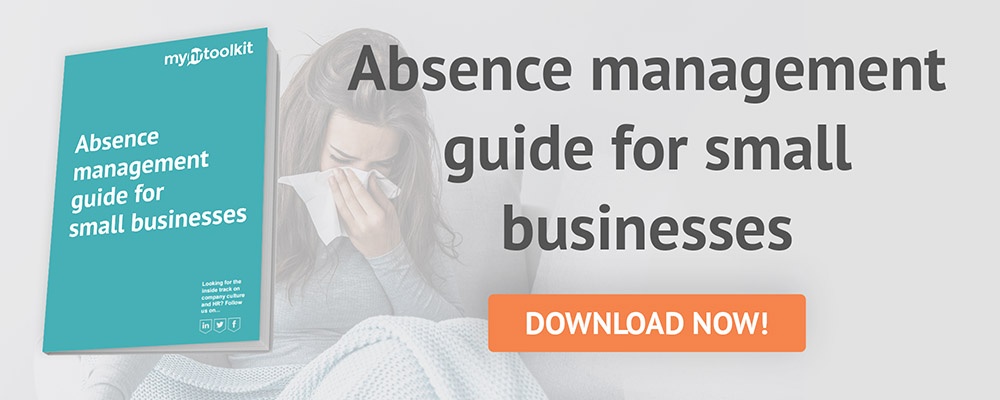Every organisation needs find ways towards managing absence effectively. Fortunately, there is a great deal that they can do to facilitate this.
Managing absence effectively: the essentials

In order to reduce absence in the workplace it’s essential to have a well-written absence policy along with trained and competent line managers who are able to implement clearly communicated standards and effective processes.
This should be combined with specialist support in managing long term health conditions and the analysis of absence data; together these are the foundations through which absence can be managed – and reduced.
But it’s important to not only manage absence but to consider attendance holistically. In addition to focusing on reducing absence, organisations can also support health and attendance at work through proactively enabling the wellbeing of the people that work for them.
Absence management and wellbeing
In 2008, the New Economics Foundation undertook extensive research into wellbeing; they considered just what is it that makes people both feel good and function well in their lives and their work. This was with a view to identifying real and practical actions that individuals and organisations can take.
The five ways to wellbeing

The research established that there are ‘five ways to wellbeing’ – five activities that people can build into their daily lives to support their wellbeing. They found that whilst there are many factors that influence wellbeing, deliberate actions can make a real difference to how people feel. The five ways to wellbeing developed from the research are:
Connect
Connecting is about developing connections with other people – friends, family and colleagues or in the community. Connections at work support a sense of belonging and enhance the employee experience.
Give
Giving to others, even by simply doing something nice for another person, enhances happiness, positive feelings and self-worth.
Be active
Regular physical activity is associated with a greater sense of well-being and lower rates of depression and anxiety. Being active is simply about building regular activity into daily life.
Take notice
Taking notice is about being aware of the world, noticing what is positive and savouring the moment.
Keep learning
Keep learning reflects the benefits to confidence, self-esteem and positive life experiences of learning new things.
By deliberately creating opportunities for employees to experience the five ways through their work and working lives, an organisation can enhance the day to day wellbeing of the people that work for them.
Using the five ways towards managing absence effectively

The starting point for enabling the five ways lies with line managers. It’s crucial that they understand there is more to their responsibilities in managing absence and enabling attendance than completing return to work interviews and monitoring triggers. Awareness raising and training can help them understand their role and how they can add value through supporting wellbeing.
It’s possible to start introducing the five ways, and wellbeing in general, though small actions. Here are some examples:
- Encourage teams to get together on a regular basis, even if it’s just for coffee or lunch, without the pressure of a work based agenda.
- Seize the small opportunities to connect people.
- Promote physical activity and create space for this in the working day.
- Introduce a lunchtime walking group. It's free, simple and helps people recharge by getting away from their desks.
- Provide regular learning and development opportunities – and not just those that relate to day to day tasks.
- Find ways in which employees can give back, either to colleagues or their local communities.
- Help people to reflect on their work and recognise team and individual success.
- Notice what is going well and say it out loud.
Manage and track staff absence much more easily with absence management software in place that's perfect for your small business.
As you can see, it's easy to start introducing the five ways in the workplace in order to manage absence effectively.
Wellbeing at work is a shared responsibility; employee, manager and organisation. Small changes can make a big difference – so why not introduce some new ways to wellbeing where you work, today?
More from our blog
How to manage unauthorised absence from work
How to address lost productivity due to employee sickness absence

Written by Gemma Dale
Gemma Dale is an experienced senior HR professional, CIPD Chartered Fellow, HEA Fellow, and a regular speaker and writer on a variety of HR topics. Gemma is the co-author of the book 'Flexible Working' published by Kogan Page in 2020. She is also a lecturer in the Business School at Liverpool John Moores University and runs her own business, The Work Consultancy.


 Holiday Planner
Holiday Planner Absence Management
Absence Management Performance Management
Performance Management Staff Management
Staff Management Document Management
Document Management Reporting
Reporting Health and Safety Management
Health and Safety Management Task Management
Task Management Security Centre
Security Centre Self Service
Self Service Mobile
Mobile




